Aliger gigas, originalmente conhecido como Strombus gigas ou mais recentemente como Lobatus gigas , comumente conhecido como a concha rainha , é uma espécie de grande caracol marinho
| Gigante de Aliger | |
|---|---|
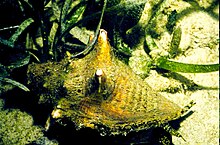 | |
| Um indivíduo vivo subadulto de Aliger gigas , in situ cercado por capim tartaruga | |
 | |
| Uma vista dorsal de um indivíduo adulto de A. gigas de Chenu , 1844 | |
| Classificação científica | |
| Reino: | Animalia |
| Filo: | molusco |
| Aula: | gastrópode |
| Subclasse: | Caenogastropoda |
| Pedido: | Littorinimorpha |
| Família: | Strombidae |
| Gênero: | Aliger |
| Espécies: | A. gigas |
| Nome binomial | |
| Gigante de Aliger | |
| Sinônimos [9] | |
Strombus gigas Linnaeus, 1758[2] | |
Aliger gigas, originalmente conhecido como Strombus gigas ou mais recentemente como Lobatus gigas , comumente conhecido como a concha rainha , é uma espécie de grande caracol marinho , um molusco gastrópode marinho da família das verdadeiras conchas , os Strombidae . Esta espécie é um dos maiores moluscos nativos do Mar do Caribe, e tropical do noroeste do Atlântico , das Bermudas ao Brasil , atingindo até 35,2 centímetros (13,9 pol) de comprimento de concha. A. gigasestá intimamente relacionado com a concha goliath, Lobatus goliath , uma espécie endêmica do Brasil, bem como a concha do galo, Aliger gallus .
A concha rainha é herbívora . Ele se alimenta procurando por material vegetal e de algas que cresce nos leitos de ervas marinhas e vasculhando matéria vegetal em decomposição. Esses grandes caracóis marinhos geralmente residem em leitos de ervas marinhas, que são planícies arenosas cobertas de ervas marinhas ondulantes e associadas a recifes de coral, embora o habitat exato dessa espécie varie de acordo com a idade de desenvolvimento. O animal adulto tem uma concha muito grande, sólida e pesada , com espinhos em forma de botão no ombro, um lábio externo largo e grosso e uma abertura característica rosa ou laranja.(abertura). A parte externa da concha rainha é de cor arenosa, ajudando-a a se misturar com o ambiente. O labelo alargado está ausente nos juvenis; desenvolve-se quando o caracol atinge a idade reprodutiva. Quanto mais grosso for o lábio alargado da concha, mais velha é a concha. [10] A anatomia externa das partes moles de A. gigas é semelhante à de outros caracóis da família Strombidae; tem um focinho longo , duas hastes oculares com olhos bem desenvolvidos, tentáculos sensoriais adicionais , um pé forte e um opérculo córneo em forma de foice .
A concha e as partes moles de A. gigas vivas servem de lar para vários tipos diferentes de animais comensais , incluindo caracóis-chinelo , caranguejos de porcelana e uma espécie especializada de peixe- cardeal conhecida como búzio Astrapogon stellatus . Seus parasitas incluem coccídios . Os predadores naturais da concha rainha incluem várias espécies de grandes caracóis marinhos predadores , polvos , estrelas do mar , crustáceos e vertebrados ( peixes , tartarugas marinhas , tubarões -lixa).). É uma fonte de alimento especialmente importante para grandes predadores, como tartarugas marinhas e tubarões-lixa. A captura e o consumo humano remontam à pré-história.
Sua concha é vendida como lembrança e usada como objeto decorativo. Historicamente, os nativos americanos e os povos indígenas do Caribe usavam partes da concha para criar várias ferramentas.
O comércio internacional da concha rainha do Caribe é regulamentado pela Convenção sobre o Comércio Internacional de Espécies Ameaçadas de Fauna e Flora Selvagens ( CITES ), no qual é listada como Strombus gigas . [11] Esta espécie não está ameaçada de extinção no Caribe como um todo, mas está comercialmente ameaçada em várias áreas, em grande parte devido à pesca excessiva .
Taxonomia e etimologia [ editar ]
História [ editar ]
A concha rainha foi originalmente descrita a partir de uma concha em 1758 pelo naturalista e taxonomista sueco Carl Linnaeus , que originou o sistema de nomenclatura binomial . [2] Linnaeus nomeou a espécie Strombus gigas , que permaneceu o nome aceito por mais de 200 anos. Linnaeus não mencionou uma localidade específica para esta espécie, dando apenas "América" como a localidade tipo. [13] O nome específico é a palavra grega antiga gigas ( γίγας ), que significa "gigante", referindo-se ao grande tamanho deste caracol em comparação com quase todos os outros moluscos gastrópodes.[14] Strombus lucifer , que foi considerado sinônimo muito mais tarde, também foi descrito por Linnaeus em Systema Naturae . [2]
Na primeira metade do século 20, pensava-se que o material tipo para a espécie havia sido perdido; em outras palavras, a concha na qual Linnaeus baseou sua descrição original e que provavelmente estaria em sua própria coleção estava aparentemente ausente, o que criou um problema para os taxonomistas. Para remediar isso, em 1941 um neótipo desta espécie foi designado pelos malacologistas americanos William J. Clench e R. Tucker Abbott . Neste caso, o neótipo não era uma concha real ou espécime inteiro , mas uma figura de um livro de 1684 Recreatio mentis, et occuli , publicado 23 anos antes do nascimento de Linnaeus pelo estudioso jesuíta italiano.Filippo Buonanni (1638-1723). Este foi o primeiro livro que era exclusivamente sobre conchas . [13] [15] [16] [17] Em 1953, o malacologista sueco Nils Hjalmar Odhner vasculhou a coleção de Linnaean na Universidade de Uppsala e descobriu o tipo de concha ausente, invalidando assim a designação de neótipo de Clench e Abbott. [18]
A taxonomia de Strombidae foi amplamente revisada na década de 2000 e alguns subgêneros , incluindo Eustrombus , foram elevados ao nível de gênero por alguns autores. [19] [20] [21] Petuch [3] e Petuch e Roberts [22] recombinaram esta espécie como Eustrombus gigas , e Landau e colaboradores (2008) a recombinaram como Lobatus gigas . [21] Em 2020, foi recombinado como Aliger gigas por Maxwell e colegas, [23] que é o nome válido atual de acordo com o Registro Mundial de Espécies Marinhas .[24]
Filogenia [ editar ]
| |||||||||||||||||||||||||||||||||||||||||||||
| Uma versão simplificada da filogenia e relações de Strombidae de acordo com Simone (2005) [19] |
| Filogenia e relações de espécies de Strombus do Pacífico Oriental e Atlântico , de acordo com Latiolais et al . (2006) [20] |
As relações filogenéticas entre os Strombidae foram estudadas principalmente por Simone (2005) [19] e Latiolais (2006), [20] usando dois métodos distintos. Simone propôs um cladograma (uma árvore de descendência) baseado em uma extensa análise morfo - anatômica de representantes de Aporhaidae , Strombidae , Xenophoridae e Struthiolariidae , que incluíam A. gigas (ali referido como Eustrombus gigas ). [19]
Com exceção de Lambis e Terebellum , os demais táxons foram anteriormente alocados no gênero Strombus , incluindo A. gigas . No entanto, segundo Simone, apenas Strombus gracilior , Strombus alatus e Strombus pugilis , as espécies-tipo , permaneceram dentro de Strombus , pois constituíam um grupo distinto baseado em pelo menos cinco sinapomorfias (características que são compartilhadas por dois ou mais táxons e seus mais recentes ancestral comum ). [19] Os táxons restantes eram anteriormente considerados subgênerose foram elevados ao nível de gênero por Simone. O gênero Eustrombus (agora considerado sinônimo de Lobatus [25] ), neste caso, incluía Eustrombus gigas (agora considerado sinônimo de Aliger gigas ) e Eustrombus goliath (= Lobatus goliath ), que eram assim considerados intimamente relacionados. [19]
Em uma abordagem diferente, Latiolais e colegas (2006) propuseram outro cladograma que tenta mostrar as relações filogenéticas de 34 espécies dentro da família Strombidae. Os autores analisaram 31 espécies de Strombus , incluindo Aliger gigas (referida como Strombus gigas ), e três espécies do gênero aliado Lambis . O cladograma foi baseado em sequências de DNA de ambas as regiões gênicas codificadoras de proteínas da histona nuclear H3 e do citocromo-c oxidase I (COI) mitocondrial . Nesta filogenia proposta, Strombus gigas e Strombus gallus (= Lobatus gallus) estão intimamente relacionados e parecem compartilhar um ancestral comum . [20]
Nomes comuns [ editar ]
Nomes comuns incluem "queen conch" e "pink conch" em inglês, caracol rosa e caracol rosado no México , caracol de pala , cobo , botuto e guarura na Venezuela , caracol reina , lambí na República Dominicana e Granada, [26] [ 27] [28] [29] [30] e carrucho em Porto Rico . [31]
Anatomia [ editar ]
Escudo [ editar ]
A casca madura cresce para 15-31 centímetros (5,9-12,2 polegadas) de comprimento em três a cinco anos [32] [33] enquanto o tamanho máximo relatado é de 35,2 centímetros (13,9 polegadas). No entanto, mesmo que eles cresçam apenas para esse comprimento máximo, a espessura da casca está aumentando constantemente. [9] [17] [34] A concha é muito sólida e pesada, com 9 a 11 espirais e um lábio externo amplamente dilatado e espesso . A espessura é muito importante porque quanto mais espessa a casca, mais protegida ela fica. Além disso, em vez de aumentar de tamanho quando atinge seu máximo, a casca externa engrossa com o passar do tempo - um indicador importante de quantos anos a concha rainha tem. [10]Embora este entalhe não seja tão bem desenvolvido como em outras partes da família, [17] a característica da concha é visível em um espécime adulto dextral (normal destro), como uma indentação anterior secundária no lábio, à direita do sifão . canal (visto ventralmente). O pedúnculo do olho esquerdo do animal se projeta através desse entalhe. [17] [31] [35] [36]
A espiral é uma parte saliente da concha que inclui todas as espirais, exceto a espiral maior e final (conhecida como espiral do corpo ). Geralmente é mais alongado do que em outros caracóis estrombídeos, como a concha goliath intimamente relacionada e maior, Lobatus goliath , que é endêmica do Brasil. [17] Em A. gigas , o acabamento brilhante ou esmalte ao redor da abertura da concha adulta é principalmente em tons pálidos de rosa. Pode apresentar uma coloração creme, pêssego ou amarela, mas às vezes também pode ser tingida com um magenta profundo , sombreando quase ao vermelho. O perióstraco , uma camada de proteína ( conchiolin), que é a parte mais externa da superfície da concha, é fina e de cor castanho-clara ou acastanhada. [33] [35] [36]
A morfologia geral da concha de A. gigas não é determinada apenas pelos genes do animal; condições ambientais, como localização, dieta, temperatura e profundidade, e interações biológicas, como predação, podem afetá-lo muito. [37] [38] Conchas juvenis desenvolvem conchas mais pesadas quando expostas a predadores. Conchas também desenvolvem conchas mais largas e grossas com menos espinhos, mas mais longos em águas mais profundas. [38]
As conchas das conchas-rainha juvenis são notavelmente diferentes em aparência daquelas dos adultos. Notável é a completa ausência de um lábio externo alargado; as conchas juvenis têm um lábio afiado simples , que dá à concha um contorno cônico ou bicônico . Na Flórida , as conchas-rainha juvenis são conhecidas como "roladores", porque a ação das ondas rola muito facilmente suas conchas, enquanto é quase impossível rolar um espécime adulto, devido ao peso e perfil assimétrico de sua concha. As conchas de subadultos têm um lábio fino e alargado que continua a aumentar de espessura até a morte. [39] [40] [41]
As conchas são cerca de 95% de carbonato de cálcio e 5% de matéria orgânica. [42]
Ilustrações históricas [ editar ]
Index Testarum Conchyliorum (publicado em 1742 pelomédicoe malacologistaNiccolò Gualtieri) contém três ilustrações de conchas adultas de diferentes perspectivas. O pináculo nodoso e o lábio externo alargado, com seu contorno semelhante a uma asa se expandindo a partir do último verticilo, é uma característica marcante dessas imagens. As conchas são mostradas como se equilibrando na borda do lábio e/ou no ápice; isso provavelmente foi feito por razões artísticas, pois essas conchas não podem se equilibrar assim.
Uma das publicações de conchas mais premiadas do século XIX, uma série de livros intitulada Illustrations conchyliologiques ou description et figures de toutes les coquilles connues, vivantes et fossiles (publicada pelo naturalista francês Jean-Charles Chenu de 1842 a 1853), contém ilustrações de conchas adultas e juvenis de A. gigas e um desenho sem cor representando algumas das partes moles do animal. [43] Quase quarenta anos depois, uma ilustração colorida do Manual of Conchology (publicado em 1885 pelo malacologista americano George Washington Tryon ) mostra uma vista dorsal de uma pequena concha juvenil com seu típico padrão marrom e branco. [41]
Partes moles [ editar ]
Muitos detalhes sobre a anatomia de Aliger gigas não eram bem conhecidos até o estudo geral de Colin Little em 1965. [44] Em 2005, RL Simone deu uma descrição anatômica detalhada. [19] A. gigas tem um focinho longo e extensível com dois pedúnculos oculares (também conhecidos como omatóforos ) que se originam de sua base. A ponta de cada pedúnculo ocular contém um olho grande e bem desenvolvido , com pupila preta e íris amarela e um pequeno tentáculo sensorial ligeiramente posterior. [17] [32] Olhos amputados se regeneram completamente . [45]Dentro da boca do animal há uma rádula (uma fita resistente coberta de fileiras de dentes microscópicos) do tipo taenioglossan . [44] Tanto o focinho quanto os pedúnculos oculares apresentam manchas escuras nas áreas expostas. O manto é de coloração escura na região anterior, desbotando para cinza claro na extremidade posterior, enquanto o colar do manto é comumente laranja. O sifão também é laranja ou amarelo. [44] Quando as partes moles do animal são removidas da casca, vários órgãos são distinguíveis externamente, incluindo o rim, a glândula nefiridial , o pericárdio , as glândulas genitais ., estômago, saco do estilete e glândula digestiva. Nos machos adultos, o pênis também é visível. [44]
Pé/locomoção [ editar ]
A espécie tem um pé grande e poderoso com manchas e marcações marrons em direção à borda, mas é branco mais próximo da corcova visceral que fica dentro da concha e acomoda os órgãos internos. A base da extremidade anterior do pé possui um sulco distinto, que contém a abertura da glândula pedal . Anexado à extremidade posterior do pé por cerca de um terço de seu comprimento está o opérculo marrom-escuro, córneo, em forma de foice , que é reforçado por uma costela central distinta. A base dos dois terços posteriores da pata do animal é arredondada; apenas o terço anterior toca o solo durante a locomoção. [19] [44] A columela, o pilar central dentro da concha, serve como ponto de fixação para o músculo columelar branco. A contração deste músculo forte permite que as partes moles do animal se abriguem na concha em resposta a estímulos indesejáveis. [44]
Aliger gigas tem um meio incomum de locomoção , descrito pela primeira vez em 1922 por George Howard Parker (1864-1955). [46] [47] O animal primeiro fixa a extremidade posterior do pé empurrando a ponta do opérculo em forma de foice no substrato, depois estende o pé para a frente, levantando e jogando a concha para a frente de forma chamado movimento de salto. Considera-se que esta forma de locomoção assemelha-se à do salto com vara , [48] tornando A. gigas um bom escalador mesmo em superfícies verticais de betão. [49]Essa locomoção saltitante pode ajudar a evitar que os predadores sigam os traços químicos do caracol, que de outra forma deixariam um rastro contínuo no substrato . [50]
Ciclo de vida [ editar ]
Aliger gigas é gonocorístico , o que significa que cada caracol individual é distintamente masculino ou distintamente feminino. [31] As fêmeas são geralmente maiores que os machos em populações naturais, com ambos os sexos existindo em proporções semelhantes. [51] Após a fertilização interna , [38] as fêmeas põem ovos em cordões gelatinosos, que podem ter até 23 metros de comprimento. [36] Estes são colocados em camadas de areia nua ou ervas marinhas. A superfície pegajosa dessas longas cordas de ovos permite que eles se enrolem e aglutinem, misturando-se com a areia ao redor para formar massas compactas de ovos, cuja forma é definida pela porção anterior do lábio externo da casca da fêmea enquanto estão em camadas.[38] [52] Cada uma das massas de ovos pode ter sido fertilizada por vários machos. [52] O número de ovos por massa de ovo varia muito dependendo das condições ambientais, como disponibilidade de alimentos e temperatura. [38] [52] Comumente, as fêmeas produzem 8–9 massas de ovos por estação, [31] [53] cada uma contendo 180.000–460.000 ovos, [36] mas os números podem chegar a 750.000 ovos. [38] As fêmeas de A. gigas podem desovar várias vezes durante a estação reprodutiva, [36] que vai de março a outubro, com picos de atividade ocorrendo de julho a setembro. [31]
Os embriões da concha rainha eclodem 3 a 5 dias após a desova. [54] [55] No momento da eclosão, a protoconcha ( concha embrionária ) é translúcida e tem uma cor de fundo creme esbranquiçada com pequenas marcas pustuladas. Esta coloração é diferente de outros Lobatus caribenhos , como Lobatus raninus e Lobatus costatus , que possuem conchas embrionárias não pigmentadas. [54] Em seguida, o emergente veliger de dois lóbulos (uma forma larval comum a vários gastrópodes marinhos e de água doce e moluscos bivalves) [ 56]passam vários dias desenvolvendo-se no plâncton , alimentando-se principalmente de fitoplâncton . A metamorfose ocorre cerca de 16 a 40 dias após a eclosão, [38] quando a protoconcha totalmente crescida tem cerca de 1,2 mm de altura. [51] Após a metamorfose, os indivíduos de A. gigas passam o resto de suas vidas na zona bentônica (sobre ou na superfície do sedimento), geralmente permanecendo enterrados durante o primeiro ano de vida. [57] A concha rainha atinge a maturidade sexual aproximadamente aos 3 a 4 anos de idade, atingindo um comprimento de concha de quase 180 mm e pesando até 5 libras. [31] [36]Os indivíduos geralmente podem viver até 7 anos, embora em águas mais profundas sua expectativa de vida possa chegar a 20 a 30 anos [36] [38] [51] e as estimativas de vida útil máxima atinjam 40 anos. [58] Acredita-se que a taxa de mortalidade tende a ser menor em conchas maduras devido à sua casca espessa, mas pode ser substancialmente maior para juvenis. Estimativas demonstraram que sua taxa de mortalidade diminui à medida que seu tamanho aumenta e também pode variar devido ao habitat, estação do ano e outros fatores.
Distribution[edit]
Aliger gigas is native to the tropical Western Atlantic coasts of North and Central America in the greater Caribbean tropical zone.[36] Although the species undoubtedly occurs in other places, this species has been recorded within the scientific literature as occurring, in:[9][59][60] Aruba, (Netherlands Antilles); Barbados; the Bahamas; Belize; Bermuda; North and northeastern regions of Brazil (though this is contested);[17] Old Providence Island in Colombia; Costa Rica; the Dominican Republic; Panama; Swan Islands in Honduras; Jamaica; Martinique; Alacran Reef, Campeche, Cayos Arcas and Quintana Roo, in Mexico; Puerto Rico; Saint Barthélemy; Mustique and Grenada in the Grenadines; Pinar del Río, North Havana Province, North Matanzas, Villa Clara, Cienfuegos, Holguín, Santiago de Cuba and Guantánamo, in the Turks and Caicos Islands and Cuba; South Carolina, Florida, with the Florida Keys and Flower Garden Banks National Marine Sanctuary, in the United States; Carabobo, Falcon, Gulf of Venezuela, Los Roques archipelago, Los Testigos Islands and Sucre in Venezuela; all islands of the United States Virgin Islands.
Habitat[edit]
Aliger gigas lives at depths from 0.3–18 m[36] to 25–35 m.[34][55] Its depth range is limited by the distribution of seagrass and algae cover. In heavily exploited areas, the queen conch is more abundant in the deepest range.[55] The queen conch lives in seagrass meadows and on sandy substrate,[51] usually in association with turtle grass (species of the genus Thalassia, specifically Thalassia testudinum[39] and also Syringodium sp.)[37] and manatee grass (Cymodocea sp.).[35] Juveniles inhabit shallow, inshore seagrass meadows, while adults favor deeper algal plains and seagrass meadows.[36][61] The critical nursery habitats for juvenile individuals are defined by a series of characteristics, including tidal circulation and macroalgal production, which together enable high rates of recruitment and survival.[62] A. gigas is typically found in distinct aggregates that may contain several thousand individuals.[38]
Diet[edit]
Strombid gastropods were widely accepted as carnivores by several authors in the 19th century, a concept that persisted until the first half of the 20th century. This erroneous idea originated in the writings of Jean-Baptiste Lamarck, who classified strombids with other supposedly carnivorous snails. This idea was subsequently repeated by other authors, but had not been supported by observation. Subsequent studies have refuted the concept, proving beyond doubt that strombid gastropods are herbivorous animals.[63] In common with other Strombidae,[20] Aliger gigas is a specialized herbivore,[33] that feeds on macroalgae (including red algae, such as species of Gracilaria and Hypnea),[41] seagrass[35] and unicellular algae, intermittently also feeding on algal detritus.[63][64] The green macroalgae Batophora oerstedii is one of its preferred foods.[36]
Interactions[edit]
A few different animals establish commensal interactions with A. gigas, which means that both organisms maintain a relationship that benefits (the commensal) species but not the other (in this case, the queen conch). Commensals of this species include certain mollusks, mainly slipper shells (Crepidula spp.) The porcelain crab Porcellana sayana is also known to be a commensal and a small cardinalfish, known as the conch fish (Astrapogon stellatus),[37] sometimes shelters in the conch's mantle for protection.[36] A. gigas is very often parasitized by protists of the phylum Apicomplexa, which are common mollusk parasites. Those coccidian[65][66] parasites, which are spore-forming, single-celled microorganisms, initially establish themselves in large vacuolated cells of the host's digestive gland, where they reproduce freely.[65][66] The infestation may proceed to the secretory cells of the same organ. The entire life cycle of the parasite typically occurs within a single host and tissue.[65]
Aliger gigas is a prey species for several carnivorous gastropod mollusks, including the apple murex Phyllonotus pomum, the horse conch Triplofusus papillosus, the lamp shell Turbinella angulata, the moon snails Natica spp. and Polinices spp., the muricid snail Murex margaritensis, the trumpet triton Charonia variegata and the tulip snail Fasciolaria tulipa.[17][32][67] Crustaceans are also conch predators, such as the blue crab Callinectes sapidus, the box crab Calappa gallus, the giant hermit crab Petrochirus diogenes, the spiny lobster Panulirus argus and others.[32][67] Sea stars, vertebrates, horse conch, octopus, eagle ray, nurse shark, fish (such as the permit Trachinotus falcatus[68] and the porcupine fish Diodon hystrix), loggerhead sea turtles (Caretta caretta) and humans also eat the queen conch.[32][67]
Uses[edit]
Conch meat has been consumed for centuries and has traditionally been an important part of the diet in many islands in the West Indies and Southern Florida. It is consumed raw, marinated, minced or chopped in a wide variety of dishes, such as salads, chowder, fritters, soups, stew, pâtés and other local recipes.[32][48][35][70] In both English and Spanish-speaking regions, for example in the Dominican Republic, Aliger gigas meat is known as lambí. Although conch meat is used mainly for human consumption, it is also sometimes employed as fishing bait (usually the foot).[58][35] A. gigas is among the most important fishery resources in the Caribbean: its harvest value was US$30 million in 1992,[38] increasing to $60 million in 2003.[71] The total annual harvest of meat of A. gigas ranged from 6,519,711 kg to 7,369,314 kg between 1993 and 1998, later production declined to 3,131,599 kg in 2001.[71] Data about US imports shows a total of 1,832,000 kg in 1998, as compared to 387,000 kg in 2009, a nearly 80% reduction twelve years later.[72]
Queen conch shells were used by Native Americans and Caribbean Indians in a wide variety of ways. South Florida bands (such as the Tequesta), the Carib, the Arawak and Taíno used conch shells to fabricate tools (such as knives, axe heads and chisels), jewelry, cookware and used them as blowing horns.[32][73] In Mesoamerican history, Aztecs used the shell as part of jewelry mosaics such as the double-headed serpent.[74] The Aztecs also believed that the sound of trumpets made from queen conch shells represented divine manifestations, and used them in religious ceremonies.[75] In central Mexico, during rain ceremonies dedicated to Tlaloc, the Maya used conch shells as hand protectors (in a manner similar to boxing gloves) during combat.[75] Ancient middens of L. gigas shells bearing round holes are considered an evidence that pre-Columbian Lucayan Indians in the Bahamas used the queen conch as a food source.[69]
Brought by explorers, queen conch shells quickly became a popular asset in early modern Europe. In the late 17th century they were widely used as decoration over fireplace mantels and English gardens, among other places.[48] In contemporary times, queen conch shells are mainly utilized in handicraft. Shells are made into cameos, bracelets and lamps,[35][76] and traditionally as doorstops or decorations by families of seafaring men.[76] The shell continues to be popular as a decorative object, though its export is now regulated and restricted by the CITES agreement.[32] In modern culture, queen conch shells are often represented in everyday objects such as coins[75][77] and stamps.[78][79]
Very rarely (about 1 in 10,000 conchs),[32] a conch pearl may be found within the mantle.[32][40] Though these pearls occur in a range of colors corresponding to the colors of the interior of the shell, pink specimens are the most valuable.[80] These pearls are considered semi-precious,[17] and a popular tourist curio.[35] The best specimens have been used to create necklaces and earrings. A conch pearl is a non-nacreous pearl (formerly referred to by some sources as a 'calcareous concretion'); it differs from most pearls that are sold as gemstones in that it is not iridescent.[80] The specific weight of the conch pearl is 2.85, notably heavier than any other type. Due to the sensitive nature of the animal and the location of the pearl-forming portion of the snail within the spiral shell, commercial cultivation of pearls is considered virtually impossible.[81]
Research into the conch shell's unique architecture is currently under way at MIT.[82]
Status[edit]
Threats[edit]
Queen conch populations have been rapidly declining throughout the years and have been mostly depleted in some areas in the Caribbean due to the fact that they are highly sought after for their meat and their value.[83] Within the conch fisheries, one of the threats to sustainability stems from the fact that there is almost as much meat in large juveniles as there is in adults, but only adult conchs can reproduce, and thus sustain a population.[70] In many places where adult conchs have become rare due to overfishing, larger juveniles and subadults are taken before they ever mate.
In the United States (Florida), it is currently illegal to gather or pick the queen conch either recreationally or commercially.[84] In other parts of the world where it is legal, only adult conchs can be fished. The rule is to let each conch have ample time to reproduce before taken out of its habitat, potentially leading to a more stable population. However, this rule has not been followed by countless fishers.[83][70][85] On a number of islands, subadults provide the majority of the harvest.[86] The abundance of Aliger gigas is declining throughout its range as a result of overfishing and poaching. Especially because of overfishing, many pockets of conch communities fall below the critical level needed for reproducing. A 2019 study predicted overfishing could lead to the extinction of queen conchs in as little as ten years.[87] Additionally, if the conch fishery collapses, it could potentially leave over 9,000 Bahamian fishers out of work.[83] Trade from many Caribbean countries, such as the Bahamas, Antigua and Barbuda, Honduras, Haiti and the Dominican Republic, is known or thought to be unsustainable.[85] As of 2001, queen conch populations in at least 15 Caribbean countries and states were overfished or overexploited.[85] Illegal harvest, including fishing in foreign waters and subsequent illegal international trade, is a common problem in the region.[58] The Caribbean "International Queen Conch Initiative" is an international attempt at managing this species.[60] On 13 January 2019, the Bahamas' Department of Marine Resources announced it would be making official recommendations to better protect the conch, including ending exports and increasing regulatory staff.[83]
Presently, ocean acidification is another serious threat to the queen conch. Acidity levels are rising and adversely affecting shellfish larvae. Rising atmospheric CO2 levels result in rising levels of carbonic acid in seawater, which is particularly harmful to organisms with calcium carbonate shells and structures. Certain larval stages of shellfish are very sensitive to lower seawater pH.[88]
Conservation[edit]
The queen conch fishery is usually managed under the regulations of individual nations. In the United States all taking of queen conch is prohibited in Florida and in adjacent Federal waters. No international regional fishery management organization exists for the whole Caribbean area, but in places such as Puerto Rico and the Virgin Islands, queen conch is regulated under the auspices of the Caribbean Fishery Management Council (CFMC).[58] In 2014, the Parties to the Convention for the Protection and Development of the Marine Environment of the Wider Caribbean Region (Cartagena Convention) included queen conch in Annex III of its Protocol Concerning Specially Protected Areas and Wildlife (SPAW Protocol). Species included in the Annex III require special measures to be taken to ensure their protection and recovery, and their use is authorised and regulated accordingly.[89][90]
This species has been mentioned in the Convention on International Trade in Endangered Species of Wild Fauna and Flora (CITES) since 1985.[38] In 1992 the United States proposed queen conch for listing in CITES Appendix II, making queen conch the first large-scale fisheries product to be regulated by CITES (as Strombus gigas).[58][91][92] In 1995 CITES began reviewing the biological and trade status of the queen conch under its "Significant Trade Review" process. These reviews are undertaken to address concerns about trade levels in an Appendix II species. Based on the 2003 review,[71] CITES recommended that all countries prohibit importation from Honduras, Haiti and the Dominican Republic, according to Standing Committee Recommendations.[93] Queen conch meat continues to be available from other Caribbean countries, including Jamaica and Turks and Caicos, which operate well-managed queen conch fisheries.[58] For conservation reasons, the Government of Colombia currently bans the commercialisation and consumption of the conch between the months of June and October.[94] The Bahamas National Trust is building awareness by educating teachers and students through workshops and an awareness campaign which includes the catchy pop song Conch Gone.[95]
References[edit]
- ^ "Appendices | CITES". cites.org. Retrieved 14 January 2022.
- ^ a b c Linnaeus, C. (1758). Systema Naturae, 10th ed., vol. 1. 824 pp. Laurentii Salvii: Holmiae (Stockholm, Sweden). p. 745.
- ^ a b Petuch, E.J. (2004). Cenozoic Seas: The view from Eastern North America. CRC Press. pp. 1–308. ISBN 978-0-8493-1632-6.
- ^ Clench, W. J. (1937). "Descriptions of new land and marine shells from the Bahama Islands." Proceedings of the New England Zoölogical Club 16: 17–26, pl. 1. (Stated date: 5 February 1937.) On pages 18–21, plate 1 figure 1.
- ^ Smith, M. (1940). World Wide Seashells: illustrations, geographical range and other data covering more than sixteen hundred species and sub-species of molluscs (1 ed.). Lantana, Florida: Tropical Photographic Laboratory. pp. 131, 139.
- ^ McGinty, T. L. (1946). "A new Florida Strombus, S. gigas verrilli". The Nautilus 60: 46–48, plates. 5–6: plate 5, figs. 2–3; plate 6, figs. 7–8.
- ^ Burry, L. A. (1949). "Shell Notes". Vol. 2. pp. 106–109.
- ^ Petuch, E. J. (1994). Atlas of Florida Fossil Shells. Chicago Spectrum Press: Evanston, Illinois., xii + 394 pp., 100 pls. On page 82, plate 20: figure c.
- ^ a b c Rosenberg, G. (2009). "Eustrombus gigas (Linnaeus, 1758)". Malacolog Version 4.1.1: A Database of Western Atlantic Marine Mollusca. Retrieved 27 September 2009.
- ^ a b "Queen Conch".
- ^ Acosta, Charles C. (2006). "Impending Trade Suspensions of Caribbean Queen Conch under CITES: A Case Study on Fishery Impacts and Potential for Stock Recovery" (PDF). Fisheries. 32 (12): 601–606. doi:10.1577/1548-8446(2006)31[601:ITSOCQ]2.0.CO;2.
- ^ Allmon, W. D. (2007). "The evolution of accuracy in natural history illustration: reversal of printed illustrations of snails and crabs in pre-Linnaean works suggests indifference to morphological detail". Archives of Natural History. 34 (1): 174–191. doi:10.3366/anh.2007.34.1.174.
- ^ a b Clench, W.J.; Abbott, R.T. (1941). "The genus Strombus in the Western Atlantic". Johnsonia. 1 (1): 1–16.
- ^ Brown, R. W. (1954). Composition of Scientific Words (PDF). Baltimore, Maryland, USA: Published by the author. p. 367.
- ^ Robertson, R. (2012). "Buonanni's Chiocciole (1681)". Digital Collections from the Ewell Sale Stewart Library and Archives. The Academy of Natural Sciences of Drexel University, Philadelphia, USA. Archived from the original on 14 January 2013. Retrieved 20 December 2012.
- ^ Buonanni, F. (1684). Recreatio mentis, et oculi in observatione animalium testaceorum Italico sermone primum proposita ... nunc ... Latine oblata centum additis testaceorum iconibus. Romae, Ex typographia Varesii. pp. 531–532.
- ^ a b c d e f g h i Moscatelli, R. (1987). The superfamily Strombacea from Western Atlantic. São Paulo, Brazil: Antonio A. Nanô & Filho Ltda. pp. 53–60.
- ^ Wallin, L. (2001). Catalogue of type specimens 4: Linnaean specimens (PDF). Uppsala, Sweden: Uppsala University Museum of Evolution Zoology section (UUZM). pp. 1–128.
- ^ a b c d e f g h Simone, L. R.L. (2005). "Comparative morphological study of representatives of the three families of Stromboidea and the Xenophoroidea (Mollusca, Caenogastropoda), with an assessment of their phylogeny". Arquivos de Zoologia. 37 (2): 178–180. doi:10.11606/issn.2176-7793.v37i2p141-267. ISSN 0066-7870.
- ^ a b c d e Latiolais, J.M.; Taylor, M.S; Roy, K.; Hellberg, M.E. (2006). "A molecular phylogenetic analysis of strombid gastropod morphological diversity" (PDF). Molecular Phylogenetics and Evolution. 41 (2): 436–444. doi:10.1016/j.ympev.2006.05.027. PMID 16839783. Archived from the original (PDF) on 20 July 2011. Retrieved 14 April 2010.
- ^ a b Landau, B.M.; Kronenberg G.C.; Herbert, G. S. (2008). "A large new species of Lobatus (Gastropoda: Strombidae) from the neogene of the Dominican Republic, with notes on the genus". The Veliger. 50 (1): 31–38. ISSN 0042-3211.
- ^ Petuch, E.J.; Roberts, C.E. (2007). The geology of the Everglades and adjacent areas. Boca Raton, Florida: CRC Press, Taylor & Francis Group. pp. 1–212. ISBN 978-1-4200-4558-1.
- ^ Maxwell, S.J.; Dekkers, A.M.; Rymer, T.L.; Congdon, B.C. (2020). "Towards resolving the American and West African Strombidae (Mollusca: Gastropoda: Neostromboidae) using integrated taxonomy". The Festivus. 52 (1): 3–38.
- ^ "Aliger gigas (Linnaeus, 1758)". World Register of Marine Species. Retrieved 3 May 2020.
- ^ Lobatus Swainson, 1837. Retrieved through: World Register of Marine Species on 5 December 2012.
- ^ Rodríguez, B.; Posada, J. (1994). "Revisión histórica de la pesquería del botuto o guarura (Strombus gigas L.) y el alcance de su programa de manejo en el Parque Nacional Archipiélago de Los Roques, Venezuela". In Appeldoorn R.; Rodríguez, B. (eds.). Queen conch biology, fisheries and mariculture. Caracas, Venezuela: Fundación Cientifica Los Roques. pp. 13–24.
- ^ Buitriago, J. (1983). "Cria en cautiverio, del huevo al adulto, del botuto (Strombus gigasL)". Memoria Sociedad de Ciencias Naturales la Salle. 43: 29–39.
- ^ Avalos, D. C. (1988). "Crecimiento y mortalidad de juveniles de Caracol rosado Strombus gigas en Punta Gavilán, Q. Roo". Documentos de Trabajo. 16: 1–16.
- ^ Eustrombus gigas (Linnaeus, 1758). Retrieved through: World Register of Marine Species on 13 August 2010.
- ^ Posada, J.M.; Ivan, M.R.; Nemeth, M. (1999). "Occurrence, abundance, and length frequency distribution of queen conch, Strombus gigas, (Gastropoda) in shallow waters of the Jaragua National Park, Dominican Republic" (PDF). Caribbean Journal of Science. 35 (1–2): 70–82.
- ^ a b c d e f Davis, M. (2005). "Species Profile: Queen Conch, Strombus gigas" (PDF). SRAC Publication No. 7203. Archived from the original (PDF) on 24 March 2012. Retrieved 17 November 2009.
- ^ a b c d e f g h i j Toller, W.; Lewis, K.A. (2003). Queen Conch Strombus gigas (PDF). U.S.V.I. Animal Fact Sheet. Vol. 19. U.S.V.I. Department of Planning and Natural Resources Division of Fish and Wildlife.
- ^ a b c Warmke, G.L.; Abbott, R. T. (1975). Caribbean Seashells. Dover Publications, Inc. p. 88. ISBN 978-0-486-21359-0.
- ^ a b Welch, J. J. (2010). "The "Island Rule" and Deep-Sea Gastropods: Re-Examining the Evidence". PLoS ONE. 5 (1): e8776. Bibcode:2010PLoSO...5.8776W. doi:10.1371/journal.pone.0008776. PMC 2808249. PMID 20098740.
- ^ a b c d e f g h Leal, J.H. (2002). "Gastropods" (PDF). In Carpenter, K. E. (ed.). The living marine resources of the Western Central Atlantic. Volume 1: Introduction, molluscs, crustaceans, hagfishes, sharks, batoid fishes and chimaeras. FAO Species Identification Guide for Fishery Purposes. FAO. p. 139.
- ^ a b c d e f g h i j k l Puglisi, M. P. (2008). "Strombus gigas". Smithsonian Marine Station at Fort Pierce. Smithsonian Institution. Archived from the original on 30 July 2009. Retrieved 26 October 2009.
- ^ a b c Tewfik, A. (1991)."An assessment of the biological characteristics, abundance, and potential yield of the queen conch (Strombus gigas L.) fishery on the Pedro Bank off Jamaica". Thesis submitted in partial fulfilment of the requirements for the Degree of Masters of Science (Biology). Acadia University, Canada.
- ^ a b c d e f g h i j k McCarthy, K. (2007). "A review of queen conch (Strombus gigas) life-history. Sustainable Fisheries Division NOAA. SEDAR 14-DW-4.
- ^ a b Davis, J.E. (2003). "Population assessment of queen conch, Strombus gigas, in the St. Eustatius Marine Park, Netherlands Antilles" Archived 19 August 2008 at the Wayback Machine. St. Eustatius Marine Park.
- ^ a b Abbott, R.T. (2002). Zim, H. S. (ed.). Seashells of The World. New York: St. Martin's Press. ISBN 978-1-58238-148-0.
- ^ a b c Tryon, G.W. (1885). Manual of Conchology, structural and systematic, with illustrations of the species. Volume 7. Terebridae, Cancellariidae, Strombidae, Cypraeidae, Ovulidae, Cassididae, Doliidae. pp.107;348.
- ^ "Conch shell gives nano insights into composite materials". ScienceDaily. Retrieved 15 April 2018.
- ^ "Chenu's Mollusks (1842–1853)". Digital Collections. The Academy of Natural Sciences. Archived from the original on 14 January 2013. Retrieved 23 September 2010.
- ^ a b c d e f Little, C. (1965). "Notes on the anatomy of the queen conch, Strombus gigas". Bulletin of Marine Science. 15 (2): 338–358. abstract.
- ^ Hughes, H.P.I. (1976). "Structure and regeneration of the eyes of strombid gastropods". Cell and Tissue Research. 171 (2): 259–271. doi:10.1007/bf00219410. PMID 975213. S2CID 25580163.
- ^ Coan, E.V.; Kabat, A.R.; Petit, R.E. (2010). 2,400 Years of Malacology (PDF) (7th ed.). American Malacological Society. p. 874. Archived from the original (PDF) on 22 April 2018. Retrieved 13 April 2010.
- ^ Parker, G. H. (1922). "The leaping of the stromb (Strombus gigas Linn.)". Journal of Experimental Zoology. 36 (2): 205–209. doi:10.1002/jez.1400360204. Archived from the original on 5 January 2013.
- ^ a b c Fish and Wildlife Research Institute (2006). "Queen conch: Florida's spectacular sea snail". Sea Stats. Florida Fish and Wildlife Conservation Commission. Archived from the original on 14 July 2011. Retrieved 31 August 2010.
- ^ Hesse, K. O. (1980). "Gliding and climbing behaviour of the queen conch, Strombus gigas" (PDF). Caribbean Journal of Science. 16: 105–108.
- ^ Berg, C.J. (1975). "Behavior and ecology of conch (superfamily Strombacea) on a deep subtidal algal plain". Bulletin of Marine Science. 25 (3): 307–317.abstract.
- ^ a b c d Ulrich Wieneke (ed.) Lobatus gigas. In: Gastropoda Stromboidea. modified: 22 November 2008. Retrieved 23 June 2009.
- ^ a b c Robertson, R. (1959). "Observations on the spawn and veligers of conchs (Strombus) in the Bahamas". Proceedings of the Malacological Society of London. 33 (4): 164–171.
- ^ Davis, M.; Hesse, C.; Hodgkins, G. (1987). "Commercial hatchery produced queen conch, Strombus gigas, seed for the research and grow-out market". Proceedings of the Gulf and Caribbean Fisheries Institute. 38: 326–335.
- ^ a b Davis, M.; Bolton, C.A.; Stoner, A.W. (1993). "A comparison of larval development, growth, and shell morphology in three Caribbean Strombus species". The Veliger. 36 (3): 236–244.
- ^ a b c Ehrhardt, N.M.; Valle-Esquivel, M. (2008). Conch (Strombus gigas) Stock Assessment Manual (PDF). U.S. Virgin Islands, Commonwealth of Puerto Rico: Caribbean Fishery Management Council. pp. 128 pp.
- ^ Brusca, R.C.; Brusca, G.J. (2003). Invertebrates (2nd ed.). Sinauer Associates, Inc. p. 936. ISBN 978-0-87893-097-5.
- ^ a b Medley, P. (2008). Monitoring and managing queen conch fisheries: A manual. FAO Fisheries Technical Paper. Vol. 514. Rome: Food and Agriculture Organization of the Uniteded Nations (FAO). ISBN 978-92-5-106031-5.
- ^ a b c d e f NOAA."Queen Conch (Strombus gigas)". Retrieved 4 July 2009.
 This article incorporates text from this source, which is in the public domain.
This article incorporates text from this source, which is in the public domain. - ^ Martin-Mora, E.; James, F. C.; Stoner, A. W. (1995). "Developmental plasticity in the shell of the queen conch Strombus gigas". Ecology. 76 (3): 981–994. doi:10.2307/1939361. JSTOR 1939361.
- ^ a b "International Queen Conch Initiative". NOAA: Caribbean Fishery Management Council. Retrieved 27 September 2009.
- ^ Stoner, A. W. (1988). "Winter mass migration of juvenile queen conch Strombus gigas and their influence on the benthic environment" (PDF). Marine Ecology Progress Series. 56: 99–104. doi:10.3354/meps056099.
- ^ Stoner, A. W. (2003). "What constitutes essential nursery habitat for a marine species? A case study of habitat form and function for queen conch". Marine Ecology Progress Series. 257: 275–289. Bibcode:2003MEPS..257..275S. doi:10.3354/meps257275. ISSN 1616-1599.
- ^ a b Robertson, R. (1961). "The feeding of Strombus and related herbivorous marine gastropods". Notulae Naturae of the Academy of Natural Sciences of Philadelphia (343): 1–9.
- ^ Stoner, A.; Ray, M. (1996). "Queen conch, Strombus gigas, in fished and unfished locations of the Bahamas: effects of a marine fishery reserve on adults, juveniles, and larval production" (PDF). Fishery Bulletin. 94 (3): 551–565.
- ^ a b c Cárdenas, E.B.; Frenkiel, L.; Zarate, A.Z.; Aranda, D.A. (2007). "Coccidian (Apicomplexa) parasite infecting Strombus gigas Linné, 1758 digestive gland". Journal of Shellfish Research. 26 (2): 319–321. doi:10.2983/0730-8000(2007)26[319:CAPISG]2.0.CO;2.
- ^ a b Gros, O.; Frenkiel, L.; Aranda, D.A. (2009). "Structural analysis of the digestive gland of the queen conch Strombus gigas Linnaeus, 1758 and its intracellular parasites". Journal of Molluscan Studies. 75 (1): 59–68. doi:10.1093/mollus/eyn041. ISSN 0260-1230.
- ^ a b c Iversen, E.S.; Jory, D.E.; Bannerot, S. P. (1986). "Predation on queen conchs, Strombus gigas, in the Bahamas". Bulletin of Marine Science. 39 (1): 61–75.
- ^ Jory, D.E. (2006). "An incident of predation on queen conch, Strombus gigas L. (Mollusca, Strombidae), by Atlantic permit, Trachinotus falcatus L. (Pisces, Carangidae)". Journal of Fish Biology. 28 (2): 129–131. doi:10.1111/j.1095-8649.1986.tb05149.x. Archived from the original on 21 October 2012.
- ^ a b Robertson, R. (2011). "Cracking a queen conch (Strombus gigas), vanishing uses, and rare abnormalities" (PDF). American Conchologist. 39 (3): 21–24. Archived from the original (PDF) on 23 September 2015.
- ^ a b c Isl, The (23 January 2013). "Virgin Islands Vacation Guide & Community". Retrieved 13 April 2010.
- ^ a b c CITES (2003). Review of Significant Trade in specimens of Appendix-II species. (Resolution Conf. 12.8 and Decision 12.75) Archived 7 July 2009 at the Wayback Machine. Nineteenth meeting of the Animals Committee, Geneva (Switzerland), 18–21.
- ^ NOAA (2009). National Marine Fisheries Service Fisheries Statistics and Economics Division. [1]. Retrieved 4 July 2009.
- ^ Squires, K. (1941). "Pre-Columbian Man in Southern Florida" (PDF). Tequesta (1): 39–46.
- ^ Colin McEwan; Andrew Middleton; Caroline Cartwright; Rebecca Stacey (2006). Turquoise Mosaics from Mexico. Duke University Press. p. 32. ISBN 0-8223-3924-2.
- ^ a b c Todd, J. (2011). "Conch shells on coins" (PDF). American Conchologist. 39 (1): 12–13. Archived from the original (PDF) on 23 September 2015.
- ^ a b Abbott, R.T.; Morris, P. A. (1995). A Field Guide to Shells. New York: Houghton Mifflin Company. pp. 184–185. ISBN 978-0-395-69779-5.
- ^ "Palau issues queen conch pearl coin". Coins Weekly. Retrieved 10 June 2015.
- ^ "Country: North America, Grenada". Stamp Collectors Catalogue. Retrieved 9 June 2015.
- ^ Moscatelli, R. (1992). Seashells on Stamps, Vol. II. Antonio A. Nano & Filho Ltd. p. 439.
- ^ a b Fritsch, E.; Misiorowski, E.B. (1987). "The History and Gemology of Queen Conch "Pearls"". Gems & Gemology. 23 (4): 208–221. doi:10.5741/gems.23.4.208. ISSN 0016-626X. Archived from the original on 29 January 2013.
- ^ "Conch Pearls: Sunken Treasure from the Caribbean". www.purepearls.com. Retrieved 4 August 2018.
- ^ "Conch shells spill the secret to their toughness". MIT News. Retrieved 15 April 2018.
- ^ a b c d "The Bahamas' iconic conch could soon disappear". 16 January 2019.
- ^ "International Affairs-Queen Conch". United States Fish and Wildlife Service. Retrieved 13 August 2019.
- ^ a b c Theile, S. (2001). "Queen conch fisheries and their management in the Caribbean" (PDF). Traffic Europe: 1–77.
- ^ Oxenford, H.A.; et al. (2007). Fishing and marketing of queen conch (Strombus gigas) in Barbados (PDF). CERMES Technical Report. Vol. 16. University of the West Indies, Barbados: Centre for Resource Management and Environmental Studies.
- ^ Stoner, Allan W.; Davis, Martha H.; Kough, Andrew S. (2019). "Relationships between Fishing Pressure and Stock Structure in Queen Conch (Lobatus gigas) Populations: Synthesis of Long-Term Surveys and Evidence for Overfishing in The Bahamas". Reviews in Fisheries Science & Aquaculture. 27 (1): 51–71. doi:10.1080/23308249.2018.1480008. S2CID 59476805.
- ^ "Ocean Acidification's impact on oysters and other shellfish". www.pmel.noaa.gov. Retrieved 15 April 2018.
- ^ "Annexes of the SPAW Protocol". SPAW-RAC's website. National Park of Guadeloupe - SPAW/RAC. Retrieved 19 October 2015.
- ^ "SPAW Protocol Annex III" (PDF). SPAW-RAC's website. National Park of Guadeloupe - SPAW/RAC. Retrieved 19 October 2015.
- ^ Appendices I, II and III. cites.org website. Retrieved 4 July 2009.
- ^ NOAA Fisheries Office of International Affairs website: CITES. Retrieved 4 July 2009.
- ^ "Standing Committee Recommendations". CITES Official Documents No 2003/057. 2003. Archived from the original on 21 October 2010. Retrieved 16 April 2010.
- ^ "Vedas Vigentes en el Territorio Colombiano". Instituto Colombiano Agropecuario (Official Website). Ministerio de Agricultura y Desarrollo Rural, Colombia. Retrieved 19 October 2015.
- ^ "Conchservation - Bahamas National Trust". bnt.bs. Retrieved 15 April 2018.
Further reading[edit]
- Coomans H.E. (1965). "Shells and shell objects from an Indian site on Magueyes Island, Puerto Rico". Caribbean Journal of Science 5 (1–2): 15–23. PDF.
- Spade, D.J.; Griffitt, R.J.; Liu, L.; Brown-Peterson, N.J.; Kroll, K.J.; et al. (2010). "Queen Conch (Strombus gigas) Testis Regresses during the Reproductive Season at Nearshore Sites in the Florida Keys". PLoS ONE. 5 (9): e12737. Bibcode:2010PLoSO...512737S. doi:10.1371/journal.pone.0012737. PMC 2939879. PMID 20856805.
- Stoner, A.W.; Waite, J.M. (1991). "Trophic biology of Strombus gigas in nursery habitats: diets and food sources in seagrass meadows". Journal of Molluscan Studies. 57 (4): 451–460. doi:10.1093/mollus/57.4.451.


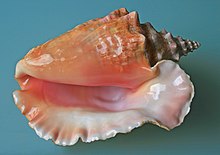


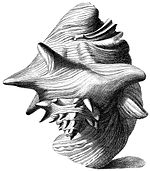

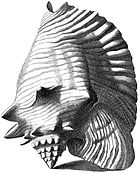

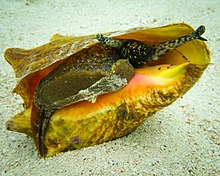



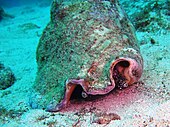


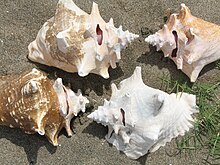

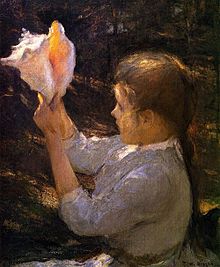
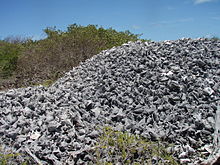
Nenhum comentário:
Postar um comentário